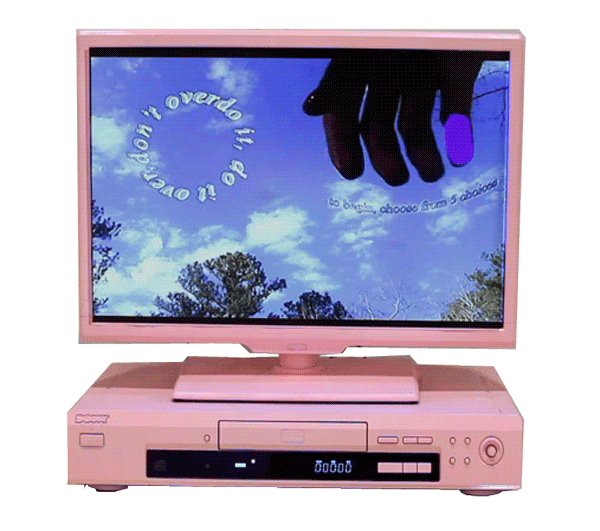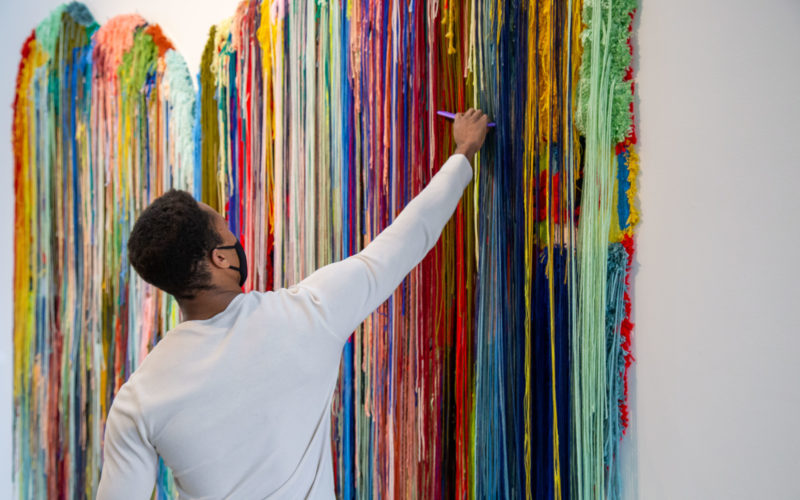Make a gift to help keep Atlanta Contemporary free, safe, and open to all.
John Riepenhoff
John Riepenhoff
August 29, 2015 – November 7, 2015
- Press Preview
- August 29, 2015 at 7:00 pm
John Riepenhoff’s exhibition consists of two parts: first, a collection of large-scale plein air paintings that depict the artist’s observations of the night sky, executed at Atlanta Contemporary in summer 2015. The second half of his solo exhibition includes a series of collaborative figurative sculptures — papier-mâché legs outfitted in Riepenhoff’s pants and shoes holding large-scale paintings by artists from Milwaukee, Chicago, New York, and Atlanta, including:
Peter Barrickman (Milwuakee)
Paul Cowan (Chicago)
Nicholas Frank (Milwuakee)
Michelle Grabner (Milwaukee / Chicago)
Kojo Griffin (Atlanta)
Elise Hanson (Milwuakee)
Amy Pleasant (Birmingham)
Amanda Ross-Ho (Los Angeles)
Nolan Simon (Detroit)
Chloe Wise (New York)
Unidentified Wisconsin folk artist
Exhibition Essay
Daniel Fuller
There were certainly art schools closer to Annapolis, MD, but when Matty Brown thought about college only one option was feasible. Before taking a job with Verizon Maryland as an Operations Project Manager, his father was born and raised Amsterdam, NY, up in Montgomery County: a benign little city known for its most famous son - Kirk Douglas – and being home to the Professional Wrestling Hall of Fame. For the Brown’s, the regional charm revolved around its proximity to the Adirondacks. The Park consists of six million acres of lakes, rivers, and 46 mountains that peak over 4,000 feet high. It’s always been a place to escape to, to get enveloped in. Each summer the Brown family would spend a timeless week deep in the woods in little cottages and lean-tos; together their endless exploration took them to fish in serene shallow streams, to paddle to secret coves, and to string their food supplies up on the highest pines, conifers, and hardwoods, out of reach of the voracious black bears who are more hungry than tall. Matty longed for the golden hours of summertime, the explorations of the blank spots on the map. Senior year the only college he applied to was Pratt Institute’s upstate campus at Munson-Williams-Proctor Arts Institute, in Utica.
Whenever the Browns went to visit family in Elmira (NY’s Southern Tier) or grandparents down on the beach in Sarasota, after all the lights went out Matty could always be found on a front porch sketching the sky. City to city, the suburban sub-divisions were uniform, but he genuinely believed that you could best get to know a place via the energy of its stars. All roads come to an end, but there is infinity to space, within the myriad of stars anywhere can be home. He was never decentered. Even when he would squeeze his eyes shut there would be these pin-pricks of energy thru the darkest gloom. Although living a comfortable life with no perceivable angst in Annapolis, he yearned to be set adrift in the deepest pockets of the Adirondacks painting that immense sky; and the closeness of Utica presented a footbridge to this opportunity.
He quickly took to college life. Living in the Hart Street Dorms with two roommates who were childhood friends from Potsdam. They were thick as thieves bonding over a mutual love of the outdoors, games at the Aud to see the minor league Comets take the ice, and a gut busting gorging sessions on Utica Greens and Chicken Riggies. Even in Freshmen Foundation classes he was able to thrive. He found that the faculty allowed him to reimagine assignments, to make the curriculum his own; he was hungry to get better and they pushed and encouraged him to think beyond what he made in high school. Best of all, his father visited during every break – including the frigid winters – and they would head for the mountains.
Before Matty’s first summer break he arranged to take an extra couple week away from his summer job at P.F. Chang’s in the Annapolis Towne Centre so that he and his roommates could paddle between Long Lake, the Raquette River and Tupper Lake. They planned a leisurely trip with a few portages, several opportunities to diverge from their planned route, and numerous nights of overindulging on local swill. Sure, the pocket money would have been nice, but peddling Walnut Shrimp with melon and Cucumber Agave Frescos to his mother’s friends no longer held the same appeal. He thought differently now. He would stay up late into the night drinking cans of cream ale with his professors talking about Constable and Rackstraw Downes, he had access to the campus museum where he’d stare at the eternal Thomas Cole’s and Frederic Church’s; after a teacher tipped him off, he fell asleep three straight nights at the library pouring over everything he could find on Vija Celmins. At first he liked the big wet-on-wet paintings by Alex Katz, but he grew out of it. The eloquence of the forest had made an instinctual impact on him. He wanted to spend his days hiding, making art, in the open.
After that first summer back in Maryland, he knew he was done. He felt most at home in that seclusion; isolation connects best with isolation. On the conclusion of his sophomore year the transfer from Pratt’s upstate campus to Brooklyn was expected. But, he knew that painting from a rooftop in Brooklyn, was not going to give him the same vitality the north did. Going back to P.F. Chang’s caused an anger to build behind his eyes. He would take this summer to plunge into the forest. His father wanted to come walk him in to the park, but Matty had outgrown these bonding moments. He had to be prepared at all times for what he didn’t know was coming next. There would be the bare essentials (instant oatmeal, Pop Tarts, Tang), but his pack also had to be free for tubes of acrylics and stretched 5” x 7” canvases. At the beginning of May he pointed his beat up car towards the town of Indian Lake, once the home of the local legend hermit: Adirondack French Louie.
Much like the Adirondack Park itself, Matty’s work was “forever wild”. He splashed paint all over his little canvases. Before college he longed to convey what he perceived as so visceral, fiery sparkle of the stars, the brightness the haziness of condensation. Outside he thought less and painted quicker. The immediacy of the wet brush slashed at the canvas, reducing the detail further and further from the infinity above him. There was no beginning or end. Whenever rain was imminent he’d jump in his 2001 Ford Focus and speed toward a valley near Hoffmeister, invigorated by the elements, he would paint in a poncho utilizing the rain as collaborator. Moments were shorter, everything urgent. It was a dance in the dark. Standing on a bed of pine needles he’d paint looking up, asymmetrical between the tree branches, blurry showers, showing the vast, errant movement of a slow pace. Deeper and deeper into the woods, he was best when there was a sense of being completely absent. The daytime was spent sleeping in order to outlast the stars. It was true action and as far from the studio as imaginable. Matty dove into canvases, with a heart racing at an uncontrollable clip. In the morning he’d wish himself a goodnight.
Through the summer, postcards would arrive back home talking about chasing pictures thru the big landscape. His writing became more philosophical, talking about maturing as an artist and man and how the limitless space was shaping his growth. Stamped in post offices in Inlet, Old Forge, Long Pond, there was tremendous movement, but never a return address. Yet, his family barely recognized the bizarre poetry in his written voice. He’d talk of a painting gone wrong at Lowe Lake’s Upper Dam and then write a week later with complete confidence about being mesmerized while painting into the morning midst near Tupper Lake. He described being restless and full of lust, like a salmon swimming upstream he was constantly moving deeper into the bowels of the Park looking for the stars no one else had put their brush to yet. There was talk of creating a road map to moments of calm. Thru these messages he was somehow still there, under the same vast sky, yet altogether absent.
The Adirondacks are a beautiful place to commune with and be transported out of this world. Perceptions change. In the wilderness a dream can quickly transform into a nightmare, which you wake from and again believe as a dream. Under the moon the back-country hiker, the lost, the painter looking for everything becomes irrelevant; they hold no confidence and even less fear, just a desire to melt away. It’s happened before, a young man retreating into the comforts of solitude residing on the very edges of their intentions. There is a point where it all goes up in smoke. Every now and again a family member or old professor would be haunted by a package containing a small canvas. Each piece of mail was like a ghostly whisper. Not that it justifies the chaos or upheaval his going off the grid caused so many, but the paintings are strikingly beautiful.
John Riepenhoff Exhibition Essay Daniel Fuller
ViewBio
John Riepenhoff
John Riepenhoff was born in 1982 in Milwaukee, WI, and received his BFA from the Peck School of the Arts at the University of Wisconsin in Milwaukee, WI. He is represented by Marlborough Gallery in New York. Riepenhoff is 2014 recipient of the Mary L. Nohl Fund Fellowship for Individual Artists. Riepenhoff is also a curator and co-owner of The Green Gallery, Milwaukee, WI; co-organizer of The Milwaukee International and Dark Fairs; and an inventor of artistic platforms for the expression of others.
His exhibitions and curatorial projects have been presented at the Tate Modern and Frieze Art Fair, London; Marlborough, Gavin Brown’s Enterprise, James Fuentes, and the Swiss Institute, New York, NY; Pepin Moore, Freedman Fitzpatrick and Ooga Booga, Los Angeles, CA; Cooper Cole, Toronto; The Suburban, Oak Park, IL; Western Exhibitions, Chicago, IL; Madison Museum of Contemporary Art and the Poor Farm, WI; and the Milwaukee Art Museum, Dean Jensen Gallery, Small Space, Milwaukee, WI.
He also continues a program of the John Riepenhoff Experience at various locations around the world.


